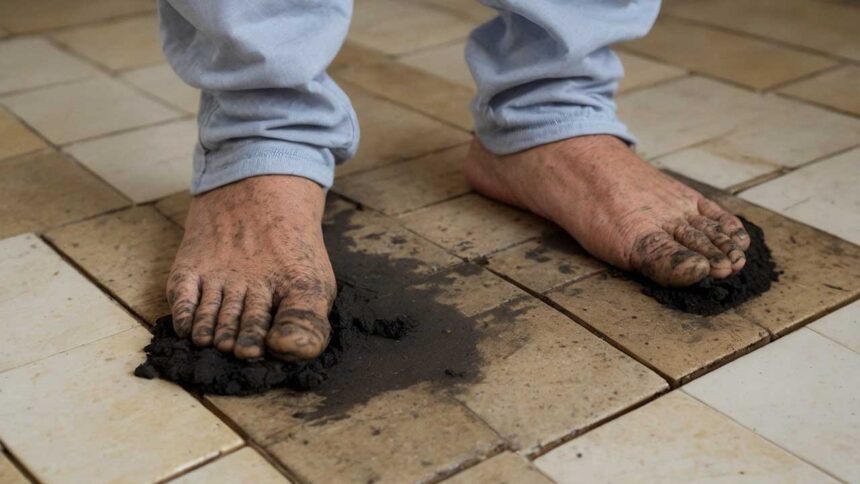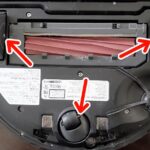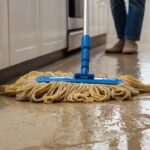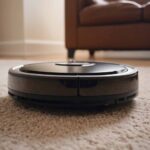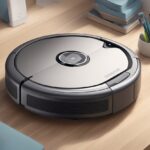Have you ever noticed your feet look like they’ve taken a stroll down a charcoal path? It’s not the best look, and it’s definitely not a sign of clean floors.
But don’t worry, I’ve got some tried-and-true solutions that will have your floors so clean; you’ll be ready to dance barefoot without a second thought!
Why Does My Floor Make My Feet Black?
Before we dive into the fixes, first, it’s important to know why this is happening so that you can get a complete idea.
It’s The Residue Left Behind
Sometimes the floor cleaners you use don’t just vanish into thin air. They leave behind a thin layer – a residue that’s not too fond of saying goodbye.
This sticky film is like a magnet for debris.
Your floor might look sparkly for a moment, but this invisible layer is busy collecting dirt, which then cozies up to your feet.
Mop Not Working Properly
What if your mop is just going in motion, but giving the actual performance it’s supposed to do? Yep, some cleaning tools, especially those that promise a quick fix, might be cutting corners.
They swoop across the floor, spreading the grime around rather than picking it up.
If you’ve been through the frustration of a mop that just won’t spray, especially when you’re in the middle of cleaning, I feel your pain. For those using a Swiffer WetJet, troubleshooting can be simple. Before you give up on it, check out these easy fixes on Swiffer WetJet not spraying here.
The Situation Of Damp Floors
Even if you’ve done the hard work of cleaning, if the floor doesn’t dry properly, you’re setting the stage for dirty feet.
Damp floors can act like glue, holding onto any debris that comes in contact with them.
When your feet press against the moist floor, they pick up this debris, leaving you with that frustrating, grimy feeling.
Unwanted Sticky Substance
Your floor could be hosting some uninvited grime.
Maybe it’s the sticky residue from tar tracked in from outside or an unidentified sticky substance that’s found a new home on your vinyl, tiles, or hardwood.
Whatever it is, it clings to your floors, and when you walk over it, it clings to your feet too.
Cracks And Crevices Collection
It’s like dirt throws a party in the tiny grooves and spaces of your flooring.
Over time, this old dirt settles in, and regular mopping might skip over these micro hiding spots, leaving your feet to do the dirty work of collecting it 😉
For those tough-to-reach corners and edges where dirt loves to settle, a regular mop might not be enough. That’s where a robo-vac can be a game changer.
Check out this guide to know about my recommended robot vacuum for cleaning corners.
Skipping Regular Cleanups
If you’re not cleaning the floors on the regular, dirt throws a takeover. It’s not just about a quick sweep.
Without a routine that involves sweeping and washing, the dirt accumulates, and the next thing you know.
Pro-Tip: Always start with a sweep or a vacuum. Jumping straight to mopping just pushes the dirt around, and it finds its way into those already-mentioned nooks and crannies. That prep step makes all the difference.
Regular cleanups are key, and sometimes a good vacuuming is what it takes before mopping. If you’re looking for a vacuum that does a thorough job cleaning up baseboards and preventing dirt from settling into crevices, I’ve got some solid recommendations for you. Check the link to learn more.
Just Light Mopping Isn’t Enough
Light mopping might keep things looking okay, but it doesn’t always cut it.
Sometimes, your floor needs a good, vigorous scrub to get rid of the deeper dirt that a gentle mop can’t reach.
Here’s How To Stop Your Floor From Making Your Feet Black
Give Your Floors a Good, Deep Clean
First things first, let’s start with a deep clean. Roll up your sleeves and grab a scrub brush, some mild detergent (for example, Murphy’s Oil Soap) and a bucket of water.
Follow the mixing directions on your detergent bottle to get the perfect cleaning solution. Now, it’s time for a little elbow grease.
Scrubbing by hand helps you really get into those little nooks and crannies where dirt likes to hide.
Plus, working with rags and clean water ensures you’re not just pushing the dirt around – you’re actually picking it up and getting rid of it.
When it comes to the deep clean, choosing the right cleaning solution is crucial. You want something effective yet safe for your floors.
By the way, do you use a Braava jet? Then you might also want to know if you can use any cleaning solutions with it.
Protect Your Clean Floors With A Seal
Now that your floor is clean, let’s talk about keeping it that way. If you’ve noticed the finish on your floor isn’t what it used to be, it might be time for a new sealant coat.
This is especially true if you’ve had to strip the floor in the past.
Sometimes it’s a DIY job, but other times you might want to call in a professional to refinish the floor. This can really lock out the dirt and keep your floors looking fresh longer.
Regular Maintenance is Key
A good sweep or a run with the vacuum can make a world of difference, especially in those trouble spots where dirt collects.
Making this a habit can prevent that buildup that’s been dirtying your feet.
Spot Clean Spills Right Away
Don’t let spills sit. Whether it’s a dropped ice cube or a splash of juice, tackle it immediately with the right cleaner for your floor type.
This prevents the spill from attracting more dirt and becoming a bigger problem.
Dry Your Floors Properly
Moisture is not the best thing when it comes to keeping floors spotless.
You’ll want to make sure you’re not just cleaning your floors but drying them thoroughly afterward. Think of it like this: just as you wouldn’t put away dishes while they’re still wet, don’t leave your floors damp.
This gives any lingering dirt a chance to cling to your floors, leading to those grimy footprints.
After mopping, take a dry mop or towel and give the floor a good once-over to soak up extra moisture.
Steam Your Way to Spotlessness
Now, if you really want to get your floors sparkling, it’s time to steam things up!
It’s all about the heat and moisture working together to gently lift and remove residue that might be causing the black feet issue.
Just remember, it might take a few sessions to tackle all that grime. Be patient, it’s worth the effort!
Change Your Water And Keep It Cleaner
Remember, dirty mop water equals dirty floors.
Frequently change the water as you clean, so you’re not just moving dirt around. With clean water, your mop is much more effective, and your floors will show the results.
If you’re considering a robot mop to keep your floors in top shape, you might wonder if you can use any cleaning solution with it. The right cleaner will ensure your floors are spotless without leaving any residue.
Trial With Gentle Cleaners
Start by testing out mild cleaners. A solution of water and vinegar can often do the trick. Just apply it to a small area first to ensure it’s effective.
Vinegar is known for its natural cleansing properties and might just be the fix you need.
If vinegar doesn’t solve the issue, try a few drops of Dawn dish soap in water. It’s gentle, but it’s also effective at cutting through grease and grime.
For persistent marks, you can try Windex. It’s not only for glass – it can work wonders on floors, too, leaving them shiny and residue-free.
Once you’ve found the cleaner that does the job, use it consistently for the best results. This will help keep your floors clean on an ongoing basis, which in turn will keep your feet free from black residue.
Approach Ammonia with Caution
If these solutions don’t work, you might consider using ammonia. It’s a strong cleaner that can tackle waxy buildups.
Remember, use ammonia in a diluted form and only as a last resort. Ventilate the area well and protect your hands with gloves when using it.
Caution: If you have no-wax floors, skip the ammonia. It’s too harsh and can damage this floor type over time.
For tile and vinyl floors, though, a blend of a cup of ammonia with half a gallon of water can effectively clean and refresh even the most neglected tiles.
How To Prevent My Feet From Getting Black From My Floor?
- Protect your feet from dirt by wearing house slippers.
- Regularly sweep your floors to remove loose debris.
- Use a vacuum for a deeper clean, especially in hard-to-reach areas.
- Change out old floor mats for new ones to reduce dirt transfer.
- Go over your floors with a damp mop to pick up any remaining debris.
- Place doormats at all entrances to catch dirt from shoes at the door.
How Often Should I Clean My Floor?
| Floor Type | Regular Cleaning | Deep Cleaning |
| Wood | Weekly with a damp mop in high-traffic areas | Every 1-2 months |
| Hardwood | Every few days sweeping or dusting, weekly vacuuming | Every 1-2 months |
| Tile | Twice a week sweeping or vacuuming | As needed, when grout looks dingy |
| Laminate | Bi-weekly | Monthly, or more often with pets/shoes indoors |
Before You Leave: A Parting Gift of Wisdom
There you have it. Floors can be tough and they require some love to stay clean.
Ignoring the little signs and skipping on the deep clean every now and then can lead to an unexpected foot makeover.
Now that we’ve covered the exact reasons and solutions to dirty floors, you can step towards cleaner floors and cleaner feet.
Like what you read? Make sure to check our blog weekly. We’ve got lots of brilliant home cleaning tips and insights coming your way!


